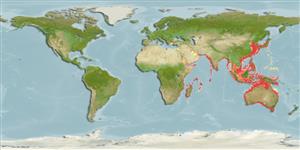Common names from other countries
Classification / Names / Names
Populärnamn | synonymer | Catalog of Fishes (gen., sp.) | ITIS | CoL | WoRMS
Environment: milieu / climate zone / depth range / distribution range
Ekologi
; djupintervall 13 - 300 m (Ref. 8), usually ? - 60 m (Ref. 801). Tropical, preferred 27°C (Ref. 107945); 41°N - 45°S, 25°E - 154°E
Indo-West Pacific and the Mediterranean.
Length at first maturity / Size / Vikt / Age
Maturity: Lm 1.7, range 2 - ? cm Max length : 2.2 cm CL hane/ej könsbestämd; (Ref. 8); 3 cm CL (female); rapporterad maxålder: 1.25 år (Ref. 117187)
Maximum depth from Ref. 801. Occurs from depths of 10 to 300 m on sand or mud (Ref. 801). Also occurs on subtidal zone, seagrass bed, and Ulva bed (Ref. 106853). Pelagic, i.e. recorded in the water column (Ref. 106854). Feeds mostly on mysids and amphipods (Ref. 116237). Omnivore (Ref. 116259).
Members of the order Decapoda are mostly gonochoric. Mating behavior: Precopulatory courtship ritual is common (through olfactory and tactile cues); usually indirect sperm transfer.
Holthuis, L.B. 1980. (Ref. 8)
IUCN Red List Status (Ref. 130435)
CITES status (Ref. 108899)
Not Evaluated
Not Evaluated
Human uses
Fiskeri: mindre kommeriell
FAO - fiskeri: landings, species profile | FishSource | Sea Around Us
Verktyg
Internet-källor
Estimates based on models
Preferred temperature
(Ref.
115969): 18 - 28.2, mean 27.1 (based on 356 cells).
Resiliens
Hög, lägsta populationsfördubblingstid mindre än 15 månader (K=0.92-2.76; tm=0.49; tmax=1.25).
Prior r = 1.19, 95% CL = 0.79 - 1.79, Based on 2 data-limited stock assessments.
Vulnerability
Low vulnerability (10 of 100).
